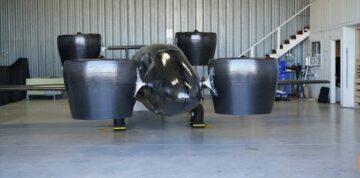
Our weekly round-up of interesting news and background stories on start-ups and innovations in supply chain and logistics. Follow @LogisticsMatter on Twitter to stay up to date on what happens in the industry.
Sustainability
With the COP27 convention fresh in mind, we’re focussing on several sustainable start-ups and innovations. Consumers prefer sustainable parcel delivery options, Amazon is increasing the number of electric vehicles in their fleet, and some interesting developments in sustainable shipping, based on ammonia and hydrogen in Norway.
Nearly half of American consumers say they would favor one e-commerce package carrier over another if it used electric vehicles (EVs) instead of gas-burning vans, according to a survey from New Hampshire-based fleet management company Merchants Fleet…
But even as they whip out their credit cards, consumers say they are increasingly aware of the environmental impact of package delivery. According to Merchants Fleet, more than 70% of consumers have considered that environmental impact of package delivery, and nearly 60% said environmental impact was at least somewhat factored into their decision to have packages shipped.
Survey: nearly half of online shoppers would choose a package delivery firm with electric vehicles
Amazon’s fleet of Rivian-made electric delivery vans is growing. Since first rolling out earlier this year, the retail giant’s new zero-tailpipe emission vehicles have made more than 5 million deliveries in the US, with its fleet-size exceeding 1,000 EDVs (electric delivery vans).
That’s still only a fraction of the company’s overall transportation fleet, which is comprised 30,000 Amazon-branded delivery vehicles and 20,000 branded trailers. But the electric-portion is growing, with Rivian eventually expecting to deliver 100,000 vans to the company.
Amazon says it has ‘over a thousand’ Rivian electric vans making deliveries in the US
The partnership will pursue opportunities with external partners, including shipowners, for Amogy to deliver its technology and Yara to deliver clean ammonia including potential integrations in tugboats, barges, offshore supply vessels and other ships.
Yara teams with ammonia-to-power startup Amogy
The two new vessels have been designed by Norwegian Ship Design, which now has orders for five hydrogen-fuelled vessels. They belong to the so-called “Powered by Nature” concept developed in cooperation with Egil Ulvan, which earlier this year unveiled plans for a zero-emission hydrogen-fuelled self-discharging bulker set to enter service in 2024.
More Norwegian hydrogen-powered bulkers to enter service
Drones & Robots
Drones, Robots, and Robo-taxi’s in this segment. We’ve written about Wing before: Size Does Matter: Wing Reveils New Delivery Drones and Google’s Wing Drones make 100,000+ deliveries. And for those that want to know more about Dronamics, I recommend listening to the podcast with Dronamics Founder Svilen Rangelov here: DRONAMICS is the First Cargo Drone Company Certified for Cross-EU Operations.
Also an interesting story on nano fulfilment, which offers a viable solution for quick commerce companies like Getyr and Gopuff, and self-driving vehicles that can officially start delivering food and groceries in San Fransisco.
DoorDash is teaming up with Alphabet’s Wing to offer customers an easier way to arrange for goods to be delivered via drone. Beginning this week, a small number of DoorDash users in Logan, Australia will be able to order certain convenience and grocery items through the DoorDash app and have them delivered by a Wing drone, typically in 15 minutes or less, Wing says.
Wing brings drone delivery options to DoorDash customers in Logan, Australia
Brought together by their mutual belief that hydrogen fuel-cell technology can open up the possibility of zero-emissions aviation, the two aerospace innovators will be working together to bring to market a viable, sustainable solution for cargo delivery services. The collaboration will focus on integrating the hydrogen fuel-cell technology CAeS is developing into the Black Swan, the flagship aircraft designed, developed and operated by Dronamics, resulting in a technically and commercially feasible zero-emissions offering.
Dronamics and Cranfield Aerospace Solutions announce partnership
Israeli startup 1MRobotics, just 18 months old, is leapfrogging micro fulfillment to nano fulfillment, using automated robotic systems within containers that can be dropped in suburban locations or fit into an urban building, fulfilling orders in lights-out fashion for delivery in as little as 15 minutes.
They may have also solved the unit economics riddle for struggling instant delivery providers like GoPuff, Gorillas and Getir, all of which are bleeding cash, cutting back staff or looking to prop each other up.
1MRobotics Focuses on Nano Fulfillment
The California Department of Motor Vehicles approved an amendment to Waymo’s existing deployment permit Wednesday to include driverless, as well as drivered, operations. Now, Waymo will be able to charge for usage of its autonomous vehicles, which will operate without anyone in the driver’s seat, for services like food and grocery delivery.
Waymo can now charge for fully driverless services in San Francisco
Cyber Security
An increasing number of companies worldwide are impacted by hackers stealing their data, or ransomware taking control of their systems. We’ve seen a big increase in cyber attacks aimed at shipping companies, transport companies and logistics service providers. No wonder the subject is getting more attention. At the same time research shows that 40% of companies are admitting they are not prepared for the rapidly changing methods of attack used by hackers. If you want to learn more about this, listen to the Does Logistics Matter? Podcast episode with Frank Breedijk, Chief Information Security Officer at Schuberg Philis here.
A Nasdaq report suggests that 14 market days after a breach becomes public, the average share price of a company bottoms out and underperforms by -3.5% on the stock exchange. An even more alarming data point is that businesses accrue more than 50% of post-breach damages as long-tail costs.
More specifically, 31% of expenses are accrued in the second year, and 24% are accrued more than two years after the breach in highly regulated industries. Still, 29% of CEOs and CISOs and 40% of Chief Security Officers admit their organizations are unprepared for the rapidly changing threat landscape.
2023 will be the year of cyber-risk quantification
In the maritime industry, the numbers are even more shocking. With the industry accounting for over 80% of global trade, a 400% increase in cyberattacks in 2022 compared to 2020 is a clear sign that the already vulnerable supply chain is at risk.
Cybersecurity: A sea of change ahead
Several supply chain and logistics companies like Hellman Logistics, CH Robinson, and Maersk have been hacked in the past years. And these are the big companies we know about because it was all over the news. Many more have been impacted that didn’t make the news…
Ransomware hit 66% of mid-sized organizations last year, up from 37% in 2020. Average ransom payments reached $812,000 during 2021, compared with $170,000 the prior year.
Cyber Threats in Supply Chain and Logistics
Start-Ups and More
Some other interesting news items below:
Header image: Photo by Fab Lentz on Unsplash
- SEO Powered Content & PR Distribution. Get Amplified Today.
- Platoblockchain. Web3 Metaverse Intelligence. Knowledge Amplified. Access Here.
- Source: https://logisticsmatter.com/start-ups-and-innovations-in-supply-chain-and-logistics-nov-7-nov-11-2022/
- 000
- 1
- 10
- 100
- 11
- 2020
- 2021
- 2022
- 2024
- 7
- 9
- a
- Able
- About
- According
- Accounting
- admit
- Aerospace
- After
- aircraft
- All
- already
- Amazon
- American
- and
- Announce
- Another
- anyone
- app
- approved
- attack
- Attacks
- attention
- Australia
- Automated
- autonomous
- autonomous vehicles
- average
- aviation
- back
- background
- based
- because
- becomes
- before
- Beginning
- belief
- below
- Big
- Black
- Bleeding
- branded
- breach
- bring
- Brings
- Building
- businesses
- california
- Cards
- Cargo
- Cash
- CEOs
- certain
- Certified
- chain
- change
- changing
- charge
- chief
- chief information security officer
- Choose
- clear
- collaboration
- Commerce
- commercially
- Companies
- company
- Company’s
- compared
- Comprised
- concept
- considered
- Consumers
- Containers
- control
- convenience
- Convention
- cooperation
- Costs
- credit
- Credit Cards
- Customers
- cutting
- cyber
- Cyber Attacks
- cyberattacks
- data
- Date
- Days
- decision
- deliver
- delivered
- Deliveries
- delivering
- delivery
- Delivery Services
- Department
- deployment
- Design
- designed
- developed
- developing
- developments
- DoorDash
- drone
- Drones
- dropped
- during
- e-commerce
- each
- Earlier
- easier
- Economics
- Electric
- electric vehicles
- emission
- Enter
- environmental
- Ether (ETH)
- Even
- eventually
- exchange
- existing
- expenses
- external
- Fashion
- favor
- feasible
- Firm
- First
- fit
- flagship
- FLEET
- fleet management
- Focus
- focuses
- food
- founder
- fraction
- fresh
- from
- fulfillment
- fully
- getting
- Global
- global trade
- goods
- groceries
- grocery
- Growing
- hacked
- hackers
- Half
- happens
- here
- highly
- Hit
- HTTPS
- hydrogen
- image
- Impact
- impacted
- in
- include
- Including
- Increase
- increasing
- increasingly
- industries
- industry
- information
- information security
- innovations
- innovators
- instant
- instead
- Integrating
- integrations
- interesting
- IT
- items
- Know
- landscape
- Last
- Last Year
- LEARN
- Listening
- little
- locations
- Logan
- logistics
- Logistics Service Providers
- looking
- made
- Maersk
- make
- Making
- management
- many
- Maritime
- Market
- Matter
- Merchants
- methods
- million
- mind
- minutes
- months
- more
- Motor
- mutual
- nano
- Nasdaq
- nearly
- New
- news
- Norway
- Norwegian
- number
- numbers
- offer
- offering
- Offers
- Officer
- officers
- Officially
- Old
- ONE
- online
- open
- operate
- operated
- Operations
- opportunities
- Options
- order
- orders
- organizations
- Other
- overall
- package
- package delivery
- packages
- partners
- Partnership
- past
- payments
- plans
- plato
- Plato Data Intelligence
- PlatoData
- podcast
- Point
- possibility
- potential
- prefer
- prepared
- price
- Prior
- providers
- public
- Quick
- Ransom
- ransomware
- rapidly
- reached
- recommend
- regulated
- report
- research
- resulting
- retail
- Risk
- rivian
- robots
- Rolling
- Said
- same
- San
- SEA
- Second
- security
- segment
- self-driving
- self-driving vehicles
- service
- service providers
- Services
- set
- several
- Share
- shipped
- Shipping
- ships
- Shoppers
- Shows
- sign
- since
- small
- solution
- Solutions
- some
- somewhat
- specifically
- Staff
- start
- start-ups
- startup
- stay
- Still
- stock
- Stock Exchange
- Stories
- Story
- Struggling
- subject
- Suggests
- supply
- supply chain
- Survey
- sustainable
- swan
- Systems
- taking
- teaming up
- teams
- Technology
- The
- their
- this week
- this year
- threat
- threats
- Through
- time
- to
- together
- trade
- transport
- transportation
- typically
- unit
- unveiled
- urban
- us
- Usage
- users
- Vehicles
- via
- viable
- Vulnerable
- waymo
- Wednesday
- week
- weekly
- What
- which
- will
- Wing
- within
- without
- working
- worldwide
- would
- written
- year
- years
- zephyrnet












